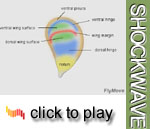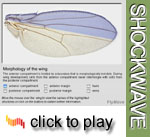The wing disc
 The
wing disc develops as a sack-like structure that will give rise to the adult
wing and surrounding boy wall tissue, the notum of the fly. The wing imaginal
discs are the largest imaginal discs in a mature 3rd instar larva. In a
sagittal section, distinct structures are visible: The disc epithelium will
give rise to the ectodermal imaginal structures such as wing with hinge,
scutum, scutellum and notum. The adepithelial cells will give rise to parts
of the imaginal muscles of the thorax. The ectodermal peripodial epithelium
contracts during wing disc eversion and also contributes to the mesothorax
of the adult fly.
The
wing disc develops as a sack-like structure that will give rise to the adult
wing and surrounding boy wall tissue, the notum of the fly. The wing imaginal
discs are the largest imaginal discs in a mature 3rd instar larva. In a
sagittal section, distinct structures are visible: The disc epithelium will
give rise to the ectodermal imaginal structures such as wing with hinge,
scutum, scutellum and notum. The adepithelial cells will give rise to parts
of the imaginal muscles of the thorax. The ectodermal peripodial epithelium
contracts during wing disc eversion and also contributes to the mesothorax
of the adult fly. During
metamorphosis, the wing disc will evert.
During
metamorphosis, the wing disc will evert.  The mature wing is a flattened pouch consisting of two opposing epithelial
sheets, connected by the wing margin. Morphologically, the wing can be subdivided
into different cells that are surrounded by veins.
The mature wing is a flattened pouch consisting of two opposing epithelial
sheets, connected by the wing margin. Morphologically, the wing can be subdivided
into different cells that are surrounded by veins.Lineage analyses have uncovered boundaries of cell lineage restriction that divide the wing disc into an anterior and a posterior "compartment". The progeny of a cell born in one compartment will never give rise to cells of the other compartment, but are restricted to one side of a morphologically invisible boundary. Cells of the posterior compartment of the wing disc inherit engrailed expression from the embryo. The anterior-posterior compartment boundary of the wing corresponds to the parasegmental boundary of the embryo.
 Cells
of the posterior compartment express hedgehog, which signals at short
range to neighboring cells. Only cells of the anterior compartment can respond
to the hedgehog signal by expressing decapentaplegic (dpp),
resulting in a narrow stripe of expression along the anterior-posterior
compartment boundary. Organizing centres have been identified in the developing
appendages of Drosophila by producing genetic mosaics that either
delete or ectopically express patterning genes in clusters of cells. This
can lead to the appearence of an ectopic organizing centre, which will exert
an influence on the surrounding tissue, thereby leading to pattern duplications.
Cells
of the posterior compartment express hedgehog, which signals at short
range to neighboring cells. Only cells of the anterior compartment can respond
to the hedgehog signal by expressing decapentaplegic (dpp),
resulting in a narrow stripe of expression along the anterior-posterior
compartment boundary. Organizing centres have been identified in the developing
appendages of Drosophila by producing genetic mosaics that either
delete or ectopically express patterning genes in clusters of cells. This
can lead to the appearence of an ectopic organizing centre, which will exert
an influence on the surrounding tissue, thereby leading to pattern duplications.A further lineage restriction later divides the wing disc into a dorsal and a ventral compartment, creating a new boundary that similarly acts as an organizing centre. The dorsal compartment is specified by the localized expression of apterous. Signaling of dorsal cells via Serrate to ventral cells leads to the expression of wingless, which acts as the organizing molecule of the dorso-ventral axis.
Media list
Genes discussed
|
Gene
|
Gene product
- Domains
|
Function
|
Links
|
| apterous (ap) | transcription factor - homeodomain; LIM domain |
involved in boundary formation in the developing wing |
Interactive Fly |
|
decapentaplegic (dpp)
|
ligand - TGF-ß homolog
|
Dpp establishes the dorsal / ventral pattern and defines
compartment boundaries
|
|
|
engrailed (en)
|
transcription factor - homeodomain
|
segment polarity gene - involved in compartment
identity and boundary formation
|
|
|
hedgehog (hh)
|
Hedgehog N-terminal signaling domain and C-terminal
autoprocessing domain
|
segment polarity gene intercellular signaling protein
|
|
|
Serrate (Ser)
|
transmembrane - EGF homolog - ligand for Notch
|
involved in the induction, through Notch, of the wing
margin
|